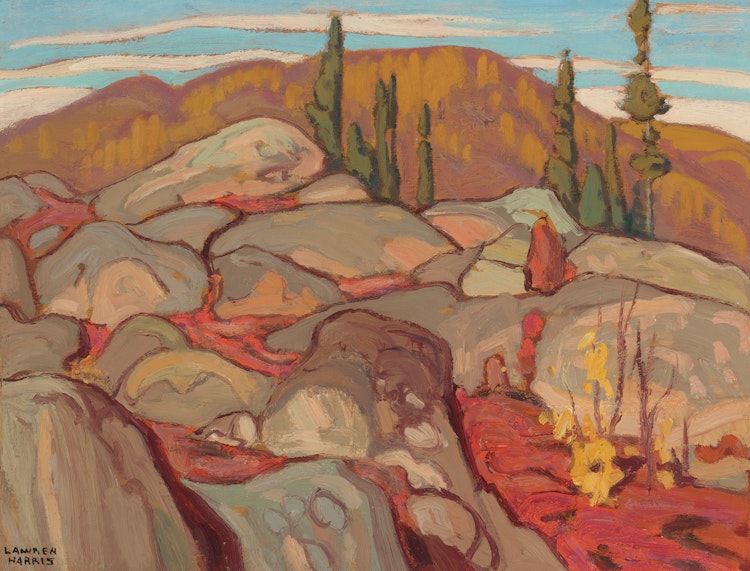In From North Shore of Lake Superior, 1921 by Lawren Stewart Harris

Lawren Harris
In From North Shore of Lake Superior, 1921
oil on wood
signed lower left; signed, titled and inscribed "7" in a circle on the reverse, titled "North Shore, Lake Superior" on a gallery label on the reverse
10.5 x 13.75 in ( 26.7 x 34.9 cm )
Auction Estimate: $175,000.00 - $225,000.00
Price Realized $264,000.00
Sale date: November 27th 2024
Collection of the Artist, Vancouver
Dominion Gallery, Montreal
Theodosia Dawes Bond Thornton, Montreal, 29 May 1951 at $250
Estate of Theodosia Dawes Bond Thornton, Montreal
Heffel, auction, Toronto, 24 November 2011, lot 159 as circa 1921-1926
Private Collection, Toronto
"Lawren Harris", Dominion Gallery, Montreal, May-June 1951
Theodosia Dawes Bond Thornton, Personal Art Collection Catalogue, unpaginated, reproduced, no. R30
A.Y. Jackson, postmarked Port Coldwell, to Florence Clement, Kitchener, 12 October [1922], Box 95, Naomi Jackson Groves Fonds, MG30-D351, Library and Archives Canada, Ottawa
Lawren S. Harris, 'The Group of Seven in Canadian History,' "The Canadian Historical Association Report of the Annual Meeting Held at Victoria and Vancouver, June 16-19, 1948", Toronto, 1948, pages 34, 35
Bess Harris, Vancouver to Max Stern, Montreal, 22 January 1951 and L. S. Harris, Vancouver to Max Stern, Montreal, 29 April 1951, both in Box 391, File 8: Emily Carr, Dominion Gallery papers, Library and Archives, National Gallery of Canada, Ottawa
'Art: Interesting works by Lawren Harris,' "The Gazette", Montreal, 26 May 1951
The two artists returned to the north shore in October 1922 and on 12 October Jackson wrote to his cousin Florence Clement in Kitchener, “A week from tomorrow we will probably board the Toronto train. Yesterday we moved from Port Munro where nobody lives to Pike Lake where nobody lives.... It has been very foggy .... Color has not been bright but the weather has. We got fed up on sunshine, and want something rough.” The cold light and restrained palette of Harris’ oil sketch "Lake Superior Country" (McMichael Canadian Art Collection, 1972.7), dated October 1922, clearly shows the artist’s sensitivity to the varying effects of light and colour resultant from the changing weather, while the bright autumn colour in this sunlit sketch suggests a possible date of fall 1921 and can be compared to Harris’ sketch confusingly titled "Country North of Lake Superior, Algoma Sketch LIII", sold by Heffel Fine Art (28 May 2014, lot 147) and catalogued as dated October 1921.
Ever since he had organized a small Group of Seven exhibition in May 1944, Max Stern hoped to be able to obtain paintings from Harris for sale at the Dominion Gallery in Montreal. Finally on 22 January 1951, following a visit to the newly opened gallery on Sherbrooke Street, Bess Harris wrote from Vancouver that they had recently received about thirty Algoma, Lake Superior and Rockies sketches that had been in storage in Toronto. On 29 April, Harris sent Stern twenty-one unframed sketches, “numbered 1 to 21 on the back of each in a circle.” Harris’ framer, Alfred Boughton of Toronto, would send him frames for the sketches. The paintings were exhibited at the Dominion Gallery at the end of May when the noted Montreal collector Theodosia Dawes Bond Thornton purchased seven sketches, including "In From North Shore of Lake Superior", that is still housed in its Boughton frame.
We extend our thanks to Charles Hill, Canadian art historian, former Curator of Canadian Art at the National Gallery of Canada and author of "The Group of Seven‒Art for a Nation", for his assistance in researching this artwork and for contributing the preceding essay.
Share this item with your friends
Lawren Stewart Harris
(1885 - 1970) Group of Seven, Canadian Group of Painters
Lawren Harris was born in Brantford, Ontario and at the age of 19 went to Berlin for academic training. His first two years included study in pencil, charcoal and watercolours. He took instruction in the studio mornings, out-of-doors sketching in the slums of Berlin afternoons, and sketching figures in the studio evenings in watercolour and drawing media. His last two years were spent in the study of portraits and figures in oils. Two of his teachers were Mr. Wille and Mr. Schlabitz. Schlabitz accompanied him in the summer on a walking tour of the Austrian Tyrol where Harris did some sketching. After his study in Germany Harris travelled in Palestine and Arabia with Norman Duncan where he did illustrations. He then visited lumber camps in Minnesota where he made illustrations for Harper’s magazine.
By 1910 Harris was back in Toronto where he saw everything with fresh eyes. His work had more vigour and sensitivity to colour and form. His first studio was located over Giles grocery store, north of Bloor and Yonge Streets. His attraction for the poorer areas of town gained him the reputation of socialist painter. His “house portraits” brought a storm of criticism against him. In Toronto the Arts and Letters Club had been formed only two years before Harris’ return and it was not long before he was an active member. It was at the Arts and Letters Club that Harris first saw the attractive sketches of J.E.H. MacDonald in 1911. Harris and MacDonald became good friends and shared an appreciation of the arts in depth. They visited Buffalo together in January of 1913 to see the exhibition of Scandinavian art which had been reviewed in art magazines. This exhibition made a deep impression on both artists. Harris took sketching trips with MacDonald in 1912 at Mattawa and Timiskaming and in 1913 they went to the Laurentians. Harris met other artists at the Arts and Letters Club. Many of them like MacDonald were working for the Grip Engraving Company as commercial artists.
In 1914 Harris and Dr. James MacCallum conceived the idea of building a studio building which could accommodate Canadian artists of ability who could devote their full attentions to painting, free from the pressures of commercialism. Many Canadian artists were drifting south to the U.S. and it was Harris’ and MacCallum’s hope that such a plan would prevent the loss of all of Canada’s most talented painters. Harris was well off through his connection with Massey-Harris (his grandfather was a founder of the firm) and so was Dr. MacCallum. They realized their plan and the Studio Building was erected on Severn Street in Toronto.
Harris became the driving force behind the Group of Seven. A.Y. Jackson claimed: "Without Harris there would have been no Group of Seven. He provided the stimulus; it was he who encouraged us always to take the bolder course, to find new trails." By 1918 Lawren Harris had travelled to the Algoma region in the company of MacDonald and Johnston. In 1920 they held an exhibition at the Art Museum of Toronto (Art Gallery of Ontario). Harris wrote “The group of seven artists whose pictures are here exhibited have for several years held a like vision concerning art in Canada. They are all imbued with the idea that an art must grow and flower in the land before the country will be a real home for its people…” Harris made his first trip to the North Shore of Lake Superior in 1921.
His search for a deeper spiritual meaning eventually took him to the stark landscapes of the far north. By the late 1920s the artist's work strove to capture the spiritual essence of the bold landforms of the Rockies and the Arctic. Throughout the ensuing decade Harris continued to simplify and abstract his landscapes until his subjects became non-representational. Lawren Harris worked as a member of the Transcendental Group of Painters in Santa Fe, New Mexico for two years, returning to Canada in 1940 and settling in Vancouver for the remainder of his lifetime.
Source: "A Dictionary of Canadian Artists, Volume II”, compiled by Colin S. MacDonald, Canadian Paperbacks Publishing Ltd, Ottawa, 1979

